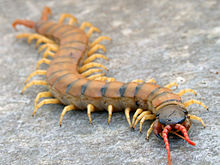Scolopendridae
| Scolopendridae Temporal range: Early Cretaceous to present
| |
|---|---|

| |
| Scolopendra cingulata | |
| Scientific classification | |
| Kingdom: | Animalia |
| Phylum: | Arthropoda |
| Subphylum: | Myriapoda |
| Class: | Chilopoda |
| Order: | Scolopendromorpha |
| Family: | Scolopendridae Newport, 1844 |
| Genera | |
|
See text. | |
The Scolopendridae are a family of large centipedes (class Chilopoda). Nearly all species in this family have four ocelli (simple eyes) on each side of the head and only 21 pairs of legs,[1] but there are exceptions: two scolopendrid species feature more legs (Scolopendropsis bahiensis, with 21 or 23 leg pairs,[2] and S. duplicata, with 39 or 43 leg pairs),[3] and some scolopendrid species are eyeless and blind (e.g., Cormocephalus sagmus, C. pyropygus, and C. delta).[4][5] Two Asian members of this family, Scolopendra cataracta and , are known to show amphibious behaviour.[6][7][8] [9]
Genera[]
- Imhoff, 1854 (= Eucorybas)
- Silvestri, 1911
- Pocock, 1891 (= Arthrorhabdinus)
- Meinert, 1885 (= Pseudocryptops)
- Ribaut, 1923
- Kraepelin, 1903
- Cormocephalus Newport, 1845
- Attems, 1930
- Tömösváry, 1882 (= Anodontastoma, Arrhabdotus)
- Ethmostigmus Pocock, 1898 (= Dacetum, Heterostoma)
- Ethmostigmus rubripes – giant centipede
- Hemiscolopendra Kraepelin, 1903
- Koch, 1985
- Porat, 1876 (= Branchiotrema)
- Kraepelin, 1903
- Meinert, 1886 (= Pithopus)
- Wood, 1862 (= Branchiostoma, Ethmophorus, Ptychotrema, Trematoptychus)
- Scolopendra Linnaeus, 1758
- Brandt, 1841
The earliest record of this family is †, an extinct genus from the Early Cretaceous of the Crato Formation of Brazil.[11]
References[]
- ^ Shelley, Rowland M. "Centipedes". ag.tennessee.edu. Retrieved 2022-02-19.
- ^ Schileyko, Arkady A. (2006). "Redescription of Scolopendropsis bahiensis (Brandt, 1841), the relations between Scolopendropsis and Rhoda, and notes on some characters used in scolopendromorph taxonomy (Chilopoda: Scolopendromorpha)". Arthropoda Selecta. 15 (1): 9–17 – via ResearchGate.
- ^ Chagas-Junior, Amazonas; Edgecombe, Gregory D.; Minelli, Alessandro (2008-09-29). "Variability in trunk segmentation in the centipede order Scolopendromorpha: a remarkable new species of Scolopendropsis Brandt (Chilopoda: Scolopendridae) from Brazil". Zootaxa. 1888 (1): 36. doi:10.11646/zootaxa.1888.1.2. ISSN 1175-5334.
- ^ Jiang, Chao; Bai, Yunjun; Shi, Mengxuan; Liu, Juan (2020-12-05). "Rediscovery and phylogenetic relationships of the scolopendromorph centipede Mimops orientalis Kraepelin, 1903 (Chilopoda): a monotypic species of Mimopidae endemic to China, for more than one century". ZooKeys. 932: 75–91. doi:10.3897/zookeys.932.51461. ISSN 1313-2970.
- ^ Edgecombe, Gregory D.; Huey, Joel A.; Humphreys, William F.; Hillyer, Mia; Burger, Mieke A.; Volschenk, Erich S.; Waldock, Julianne M. (2019). "Blind scolopendrid centipedes of the genus Cormocephalus from subterranean habitats in Western Australia (Myriapoda: Scolopendromorpha: Scolopendridae)". Invertebrate Systematics. 33 (6): 807–824. doi:10.1071/IS19015. ISSN 1445-5226.
- ^ Holmes, O. (1 July 2016). "Giant swimming, venomous centipede discovered by accident in world-first". The Guardian. Retrieved 1 July 2016.
- ^ Bates, M. (26 June 2016). "'Horrific' First Amphibious Centipede Discovered". National Geographic. Retrieved 1 July 2016.
- ^ Gravely, F.H. ″Two new species of Scolopendridae″, Records of the Indian Museum, Volume 7, 1912, p. 415
- ^ Siriwut, W.; Edgecombe, G. D.; Sutcharit, C.; Tongkerd, P.; Panha, S. (2016). "A taxonomic review of the centipede genus Scolopendra Linnaeus, 1758 (Scolopendromorpha, Scolopendridae) in mainland Southeast Asia, with description of a new species from Laos". ZooKeys (590): 1–124. doi:10.3897/zookeys.590.7950. PMC 4926625. PMID 27408540.
- ^ "Sterropristes", Animal Diversity Web, Museum of Zoology, University of Michigan, accessed March 26, 2017
- ^ "Fossilworks: Cratoraricrus oberlii". fossilworks.org. Retrieved 17 December 2021.
External links[]
| Wikimedia Commons has media related to Scolopendridae. |
| Wikispecies has information related to Scolopendridae. |
thumb ZAMN
Categories:
- Scolopendridae
- Centipede families